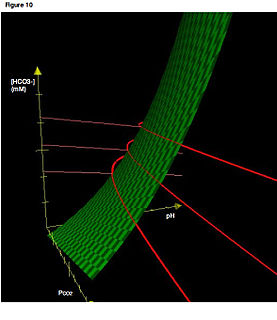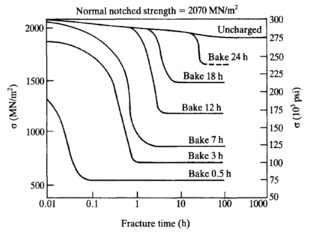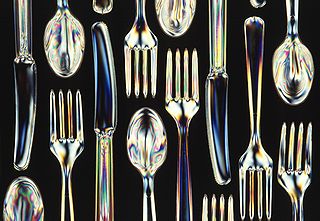
Biodegradation is the breakdown of organic matter by microorganisms, such as bacteria, fungi.
A mechanical or physical shock is a sudden acceleration caused, for example, by impact, drop kick, earthquake, or explosion. Shock is a transient physical excitation.

An arterial-blood gas (ABG) test measures the amounts of arterial gases, such as oxygen and carbon dioxide. An ABG test requires that a small volume of blood be drawn from the radial artery with a syringe and a thin needle, but sometimes the femoral artery in the groin or another site is used. The blood can also be drawn from an arterial catheter.
Permeability in fluid mechanics and the earth sciences is a measure of the ability of a porous material to allow fluids to pass through it.

Hydrogen embrittlement is the process by which hydride-forming metals such as titanium, vanadium, zirconium, tantalum, and niobium become brittle and fracture due to the introduction and subsequent diffusion of hydrogen into the metal.

A heat sealer is a machine used to seal products, packaging, and other thermoplastic materials using heat. This can be with uniform thermoplastic monolayers or with materials having several layers, at least one being thermoplastic. Heat sealing can join two similar materials together or can join dissimilar materials, one of which has a thermoplastic layer.

Modified atmosphere is the practice of modifying the composition of the internal atmosphere of a package in order to improve the shelf life.The need for this technology for food arises from the short shelf life of food products such as meat, fish, poultry, and dairy in the presence of oxygen. In food, oxygen is readily available for lipid oxidation reactions. Oxygen also helps maintain high respiration rates of fresh produce, which contribute to shortened shelf life. From a microbiological aspect, oxygen encourages the growth of aerobic spoilage microorganisms. Therefore, the reduction of oxygen and its replacement with other gases can reduce or delay oxidation reactions and microbiological spoilage. Oxygen scavengers may also be used to reduce browning due to lipid oxidation by halting the auto-oxidative chemical process.
Hydraulic conductivity, symbolically represented as
, is a property of vascular plants, soils and rocks, that describes the ease with which a fluid can move through pore spaces or fractures. It depends on the intrinsic permeability of the material, the degree of saturation, and on the density and viscosity of the fluid. Saturated hydraulic conductivity, Ksat, describes water movement through saturated media.
By definition, hydraulic conductivity is the ratio of velocity to hydraulic gradient indicating permeability of porous media.

A vapor barrier is any material used for damp proofing, typically a plastic or foil sheet, that resists diffusion of moisture through the wall, floor, ceiling, or roof assemblies of buildings to prevent interstitial condensation and of packaging. Technically, many of these materials are only vapor retarders as they have varying degrees of permeability.

The three-point bending flexural test provides values for the modulus of elasticity
in bending
, flexural stress
, flexural strain
and the flexural stress–strain response of the material. The main advantage of a three-point flexural test is the ease of the specimen preparation and testing. However, this method has also some disadvantages: the results of the testing method are sensitive to specimen and loading geometry and strain rate.

Biodegradable plastics are plastics that can be decomposed by the action of living organisms, usually bacteria.
Dissolved gas analysis (DGA) is the study of dissolved gases in transformer oil.
A gas pycnometer is a laboratory device used for measuring the density—or, more accurately, the volume—of solids, be they regularly shaped, porous or non-porous, monolithic, powdered, granular or in some way comminuted, employing some method of gas displacement and the volume:pressure relationship known as Boyle's Law. A gas pycnometer is also sometimes referred to as a helium pycnometer.

Package testing or packaging testing involves the measurement of a characteristic or property involved with packaging. This includes packaging materials, packaging components, primary packages, shipping containers, and unit loads, as well as the associated processes.
Biodegradable additives are additives that enhance the biodegradation of polymers by allowing microorganisms to utilize the carbon within the polymer chain itself.
The four-point bending flexural test provides values for the modulus of elasticity
in bending
, flexural stress
, flexural strain
and the flexural stress-strain response of the material. This test is very similar to the three-point bending flexural test. The major difference being that the addition of a fourth bearing brings a much larger portion of the beam to the maximum stress, as opposed to only the material right under the central bearing.










